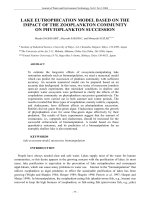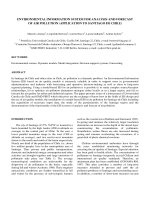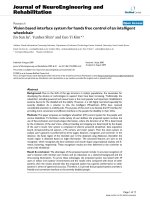Cyber-physical system based productivity improvement concept of construction 4.0
Bạn đang xem bản rút gọn của tài liệu. Xem và tải ngay bản đầy đủ của tài liệu tại đây (570.05 KB, 4 trang )
Cyber-physical system based productivity
improvement concept of construction 4.0
Khái niệm cải tiến năng suất xây dựng 4.0 dựa trên hệ thống thực ảo
Hande Ünlü(¹), Norihiko Goto(²)
Tóm tắt
Đã từ lâu, tốc độ thực hiện việc cải tiến
năng suất của các công nghệ liên quan
trong ngành xây dựng luôn bị chậm hơn
so với các ngành công nghiệp khác. Tuy
nhiên, do sự suy giảm số lượng công
nhân có tay nghề và sự thay đổi động
lực thị trường tại Nhật bản, một số các
giải pháp khác nhau đã đi vào trọng
tâm của quá trình chuyển đổi sản phẩm.
Trong bài báo này, chúng tôi giới thiệu
khái niệm về Xây dựng 4.0, trong đó
nâng cao Hệ Thống Thực Ảo, bằng cách
đưa ra bối cảnh cách mạng, lịch sử cải
tiến năng suất trong ngành xây dựng
Nhật Bản.
Từ khóa: Hệ thống Thực - Ảo, Xây dựng 4.0, số
hóa, cải tiến năng suất
Abstract
Implementation speed of productivity
improvement associated technologies in
construction industry has always remained
behind other industries for long time.
However, due to decreasing number of skilled
workers and changing market dynamics
in Japan several different solutions have
come into focus of process and product
transformation. In this paper, we introduce
our concept of Construction 4.0 that is
proposed to raise upon Cyber-Physical
Systems, by giving its revolution background,
a history of productivity improvement in
Japanese construction industry.
Keywords: Cyber-Physical Systems,
Construction 4.0, digitization, productivity
improvement
1. Introduction
Industry 4.0 or the fourth industrial revolution is the current trend of automation
and data exchange in manufacturing technologies with an aim to establish Smart
Production. The key technologies of Industry 4.0 have a strong focus on digitization and
integration of vertical and horizontal value chains, digitization of product and service
offerings, digital business models and customer/user access [1].
However, it hasn’t been a smooth process to adapt these technologies into the works
at construction industry easily. The main challenges of construction industry could be
listed as 1- its complexity: high number of components to be designed and implemented
in parallel 2- increased uncertainties and different patterns at each project, 3- the rigid
culture of construction which doesn’t allow fast changes compared to other industries
such as automotive, 4- fragmented supply chain: high number of work packages done
by many different subcontractors and 5- short-term thinking: dominant way of thinking
that is project-based, to be achieved under limited time and resources [2].
Technology development, implementation of new construction methods and its
adaptation into the site works require interdisciplinary comprehensive planning of
product and process transformation. Often, the transformation is a big challenge for
large design and construction companies to implement new methods [3]. However, due
to the reasons which are focused in this paper, construction industry is heading towards
Construction 4.0 and competition is becoming more contentious towards digitization of
projects from planning to design, construction and facility management stages.
2. A Concept for Construction 4.0
Inspired by Industry 4.0’s key technologies on digitization of production and
coordination by ICT, there have been several concepts introduced for defining
Construction 4.0 by Japanese organizations [4] and other international institutes.
Associatively, Takenaka Corporation visualizes Construction 4.0 as a fusion of
disruptive and incremental type of product and process transformation that results in
productivity improvement [Figure 1].
Despite the speed of revolution in manufacturing industry, construction has always
been more conventional and almost 20 years behind to adapt cutting edge technologies
(1) Ph.D.,Engineer,Takenaka
Corporation
Email:
(2) M.Sc.,Engineer,Takenaka
Corporation
Email:
Figure 1. Takenaka’s Vision of Construction 4.0
S¬ 28 - 2017
101
KHOA H“C & C«NG NGHª
Figure 2. CPS Platform Concept for Construction 4.0
Figure 3. ASTM Project, 1979
into practice. However, today, design and construction tools
have been significantly improved such as use of BIM, CNC/3D
printing technologies, VR (Virtual Reality)/AR (Augmented
Reality) systems and so on. As foreseen within the frame of
Takenaka’s vision of Construction 4.0, construction industry
will reach the age of digital fabrication soon in the near
future [5]. This is an inevitable evolution in construction for
productivity improvement at countries such as Japan which
has a struggle with decreasing number of skilled workers
and correspondingly increasing amount of investment in
automation and robotics applications to overcome the labor
problem [6].
In Japan a CPS platform has already been being
promoted by the government since 2015 under the project
named “I-Construction” (ICT-Integrated Construction). By
introducing standards and regulations about ICT-Integrated
construction besides taking advantages of such technologies
as drones and auto-heavy machines, the ministry aims to
102
increase productivity of trade workers by 50%. Such initiation
at government level boosts the industry towards the age of
digitization rapidly.
Due to the fact, we have examined the inevitable necessity
of productivity improvement and possibilities that digitization
may offer to us. We have developed a concept of CyberPhysical System (CPS) for Construction 4.0 as introduced
in Figure 2. Our concept of a CPS platform provides
transformations that is built upon 1- Digitalized design &
engineering, 2- Digitized Procurement & Management, 3Digitized Logistic & Production System, 4- Smart Building
Operation & Maintenance, 5- Smart Facility Management
system and 6- Using Lifecycle Data for Design & Engineering.
3. Productivity improvement in Japan in the age of
Construction 2.0 and 3.0
In the 1970s, in Japan, productivity improvement has
been studied and implemented by utilizing construction
T„P CHŠ KHOA H“C KI¦N TR”C - XŸY D¼NG
skilled workers were still engaged in big numbers. 3- During
1970s a large burden was placed on the amount of required
detailed hand drawings for the prefabrication process at
factories. However, by the use of composite solutions
(combination of prefabricated elements with conventional
in-situ production) large amount of time and cost could be
saved both from design and construction phases.
Figure 4. Detection system network
During the age of Construction 3.0 including the large
amount of today’s current projects, in Japan, composite
construction solutions became a key for productivity
improvement. By this way, the market demand on design
variety could be constructed in a more flexible way compared
to modularization method.
By the use of CAD and later BIM tools, today, complicated
architectural structures could be analyzed to select the most
efficient construction methods through different scenarios
digitally. We utilize BIM to optimize the production process
by analyzing different scenarios and increase the efficiency
of entire project. Table 1 presents the brief transition history
of efficient methods from 1970s until today.
4. CPS based productivity improvement in the age of
Construction 4.0
Figure 5. System output on a drawing file
automation through modularization [7]. We call this period
the era of Construction 2.0. Modularized buildings such as
Takenaka’s ASTM project (mass housing project of 3,381
dwelling units; completion: 1979), had been achieved by
significant transformations in the way of production, design,
logistics and assembly [Figure 3].
Briefly, the housing modules of: precast (PCa) concrete
external walls with fitted windows, PCa floor slabs and
prefabricated kitchens and bathrooms including its
mechanical and electrical installations had been built at
factories and delivered just in-time. Such modules were
rapidly assembled and pluggedinto the steel structural frame onsite. This method was a unique
approach implemented in Japan
which had successfully saved
time, cost and resources in the
1970s.
However, since then the use
of modularization method which
is recently a trend across the
world (such as prefabricated
skyscrapers) has become less
popular in Japan. With the
beginning of 1980s Japan has
already moved forward into
Construction 3.0. The main
reasons that triggered the 3rd
revolution in Japan are 1- In the
1980s rapid growths in Japanese
economy lowered the need of
mass housing while creating
a market demand change into
“quality rather than quantity”. Due
to the fact, diversity in design
became more important. 2- Labor
costs had decreased whilst highly
On the other hand, at our most recent projects putting our
concept of Construction 4.0 [Figure 1] in the core, we have
been researching and testing incrementally the adaptation
of CPS based productivity improvement through digitization.
Below are two applications that we’ve developed for the
adaptation of PIM (Process Info Modelling) which is a vital
component of Digitized Procurement & Management [Figure
2] in CPS based productivity improvement:
Machinery and labor position detecting system: At
construction sites it’s a time consuming process to find
location of machineries (sometimes there are hundreds of
aerial work platforms (AWP) on site) and analyze the efficiency
of workers by their work locations. In order to improve our onsite productivity, we have developed an information gathering
system that uses wireless transmitter technology of iBeacon.
Figure 6. Image of the cloud-based management
S¬ 28 - 2017
103
KHOA H“C & C«NG NGHª
Table 1. The triggering challenges and outputs of each construction revolution
Our system is the first indoor position detection technology
that uses iBeacon at a construction site. As shown in Figure
4, fixed and mobile iBeacons transmit location information of
machineries and workers to the Site Management Server via
data receivers on site. Output data indicates their location
by symbols on project’s actual drawing layout [Figure 5].
By utilizing this real-time detection system, we save time
on searching of machineries and workers. We have also
developed a photo shooting application for iPad that takes
photos of on-going works on site and uploads to server
together with its location information. By this application we
save more than 30% of man-hour spent for documenting
on-going works for the site management. Utilizing the above
mentioned methods, we have improved the efficiency of our
site management tasks by saving 72 hours of work time in 6
months.
Cloud-based remote monitoring system utilizing IoT: Due
to increasing number of on-site machineries, management
of real-time operating status and maintenance has become
a more time consuming process. Aiming to improve the
efficiency of operation and maintenance works, we have
developed a remote cloud-based machinery monitoring
system by the use of IoT technology [Figure 6]. This system
can detect a risk of machinery failure in real-time which could
Tài liệu tham khảo
1. PwC, Industry 4.0: Building the digital enterprise, Global Industry
4.0 Survey – Industry key findings, 2016.
2. T. D. Oesterreich, F. Teuteberg, Understanding the Implications
of Digitization and Automation in the Context of Industry 4.0: A
triangulation approach and elements of a research agenda for the
construction industry, Computers in Industry, Vol.83, 2016
be monitored remotely via cloud system at the office or on
site. In addition, this system enables a central management of
data between the machinery and manufacturers. In the future,
we are aiming to utilize the big data that has been collected
by this system for integrated construction automation.
Above mentioned applications are only two examples of
a future CPS that integrates digitization at every phase of
projects for productivity improvement.
5. Concluding Remarks
At our concept of Construction 4.0, projects are being
based on digitized platforms and automation applications
from planning to construction and facility management
activities. Modularization method which provided improved
productivity in the era of Construction 2.0 was evolved into
composite solutions during the era of Construction 3.0 driven
by changing market dynamics. As observed during earlier
construction revolutions, Construction 4.0 will bring product
and process transformation too. Given today’s technological
advancements, we believe that the future of construction
industry will reach productivity improvement by benefiting
from digitized platforms in the form of Cyber-PhysicalSystems as introduced in this paper./.
4. General Competitiveness Forum of Japan (COCN), Smart
Construction System Using IoT and CPS (in Japanese), Industry
Competitiveness Discussion Proceeding, 2015
5. M. Kohler, F. Gramazio, The Robotic Touch: How Robots Change
Architecture, Park Books, 2014
6. MLIT, i-Construction (in Japanese), />tec_tk_000028.html, latest access on 14 July 2017
3. C. Christensen, Innovator’s Dilemma: When New Technologies
Cause Great Firms to Fail, Harvard Business Review Press,
Reprint edition January 5, 2016
104
T„P CHŠ KHOA H“C KI¦N TR”C - XŸY D¼NG









